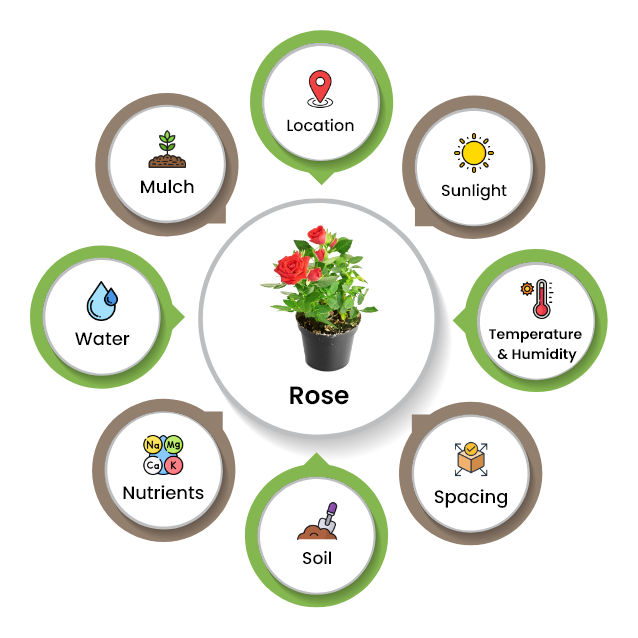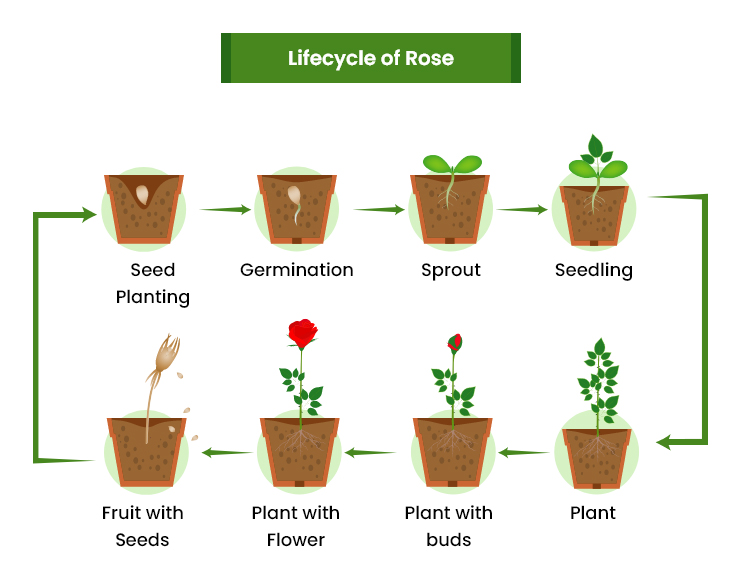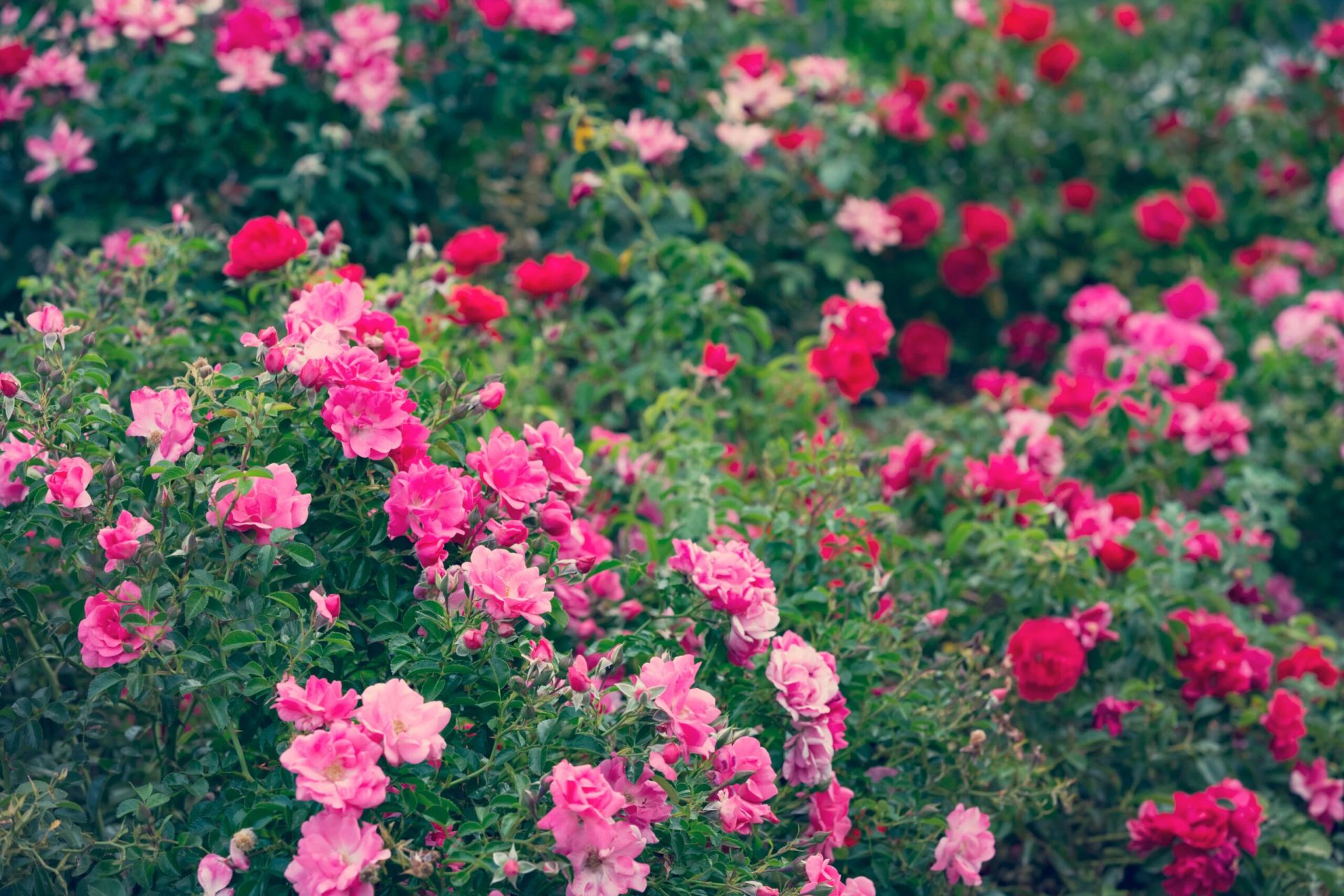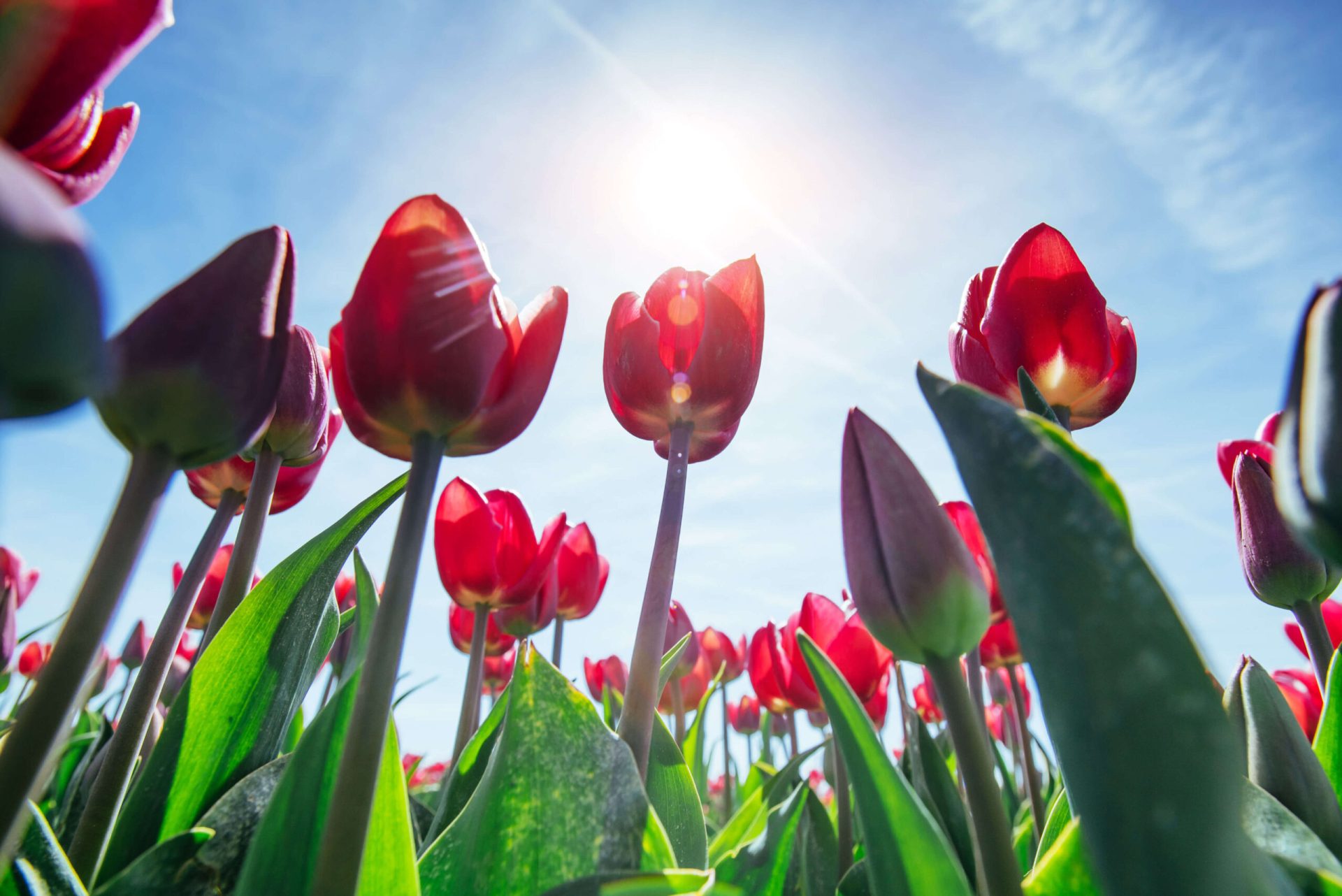Roses are versatile flowers cultivated for their beauty, fragrance, and therapeutic properties. Whether you have a limited space or a large garden , growing rosesis a must in your flower garden.
Roses have a reputation among gardeners for being finicky. However, this guide will make growing roses a breeze. We offer tips, advice and common culivation problems in our rose growing guide.
Growing Rose 101: Step-by-Step Guide

1. Location
Select a spot with no root competition from other large trees or shrubs. Roses like space to grow and do not like competing for resources.
2. Sunlight
Ensure your rose bushes receive 6-8 hours of full sunlight. If your plants receive less sunlight, they will not bloom properly and will be more susceptible to pests and diseases. No rose variety likes full shade.
3. Temperature
During the growing season, the ideal temperature for roses is between 60°F and80°F.
4. Humidity
Roses like some moisture in the air and may struggle in more arid environments. An ideal mid-day relative humidity for roses is 45%.
5. Spacing
Plant rose bushes 3 feet apart from other plants to avoid competition for soil nutrients. Some rose bushes can grow as long as 8 feet wide. Therefore, provide more space for these sprawling varieties.
6. Soil
Rose plants require a pH of 6 to 7, slightly acidic to neutral. A neutral soil encourages healthy growth. Additionally, roses prefer soil with a medium-to-heavy loam over a good clay sub-soil.
Tip. Consider the mature size of your rose bushes. Provide enough space to accommodate its fully grown size.
7. Fertilizer
Use a high-nitrogen fertilizer for the first application. This will encourage healthy foliage growth. Roses also like Epsom salt as a soil amendment. Epsom salts promote new cane development and lusher blooms. After the first application, add a slow-release fertilizer when shoots grow to 4 to 5 inches
8. Water
Rose bushes require 1 to 2 inches of water weekly from early spring to fall. Increase the watering frequency every three to four days in hot and dry weather
9. Mulch
Apply a mulch 1- to 2-inch layer around the base of the rose bush. Shredded leaves, grass clippings, or shredded bark work well. Spread the mulch to the width of the rose canopy. Another option: Use well-rotted manure.
How to Grow Rose in Pots?
Growing roses in pots gives you control over water, soil, and sunlight for better growth.
- Select a relatively large and tall pot. Your container should measure no less than 15 inches in diameter.
- Choose clay pots, as they are better than plastic. Clay slows down the transfer of heat from the sun into the soil.
- Ensure the pots have enough drainage holes.
- Use a well-draining potting medium. This will decrease the likelihood of rot and is heavy enough to hold moisture.
- Add a cup of perlite (to promote drainage) and bonemeal (as a nutrient) to the soil.
- Fill two-thirds of the pot with your prepared soil mix.
- For a bare-root rose, hill the soil in the center, place rose over it, and spread the roots out over the mound.
- For a transplanted rose bush, create a slight indentation, remove the rose from the container, and place it in the pot.
- After planting, water it thoroughly so that the soil becomes well-saturated.
- If you are growing a group of potted roses, space them at least 2 feet apart to ensure good air circulation.
- Apply fertilizer every two weeks for healthy plant growth and vibrant flowers.
- Apply fertilizer to the soil (avoid leaves), as the fertilizers’ salts can burn the foliage.
- Stop fertilizing about eight weeks before the expected first winter frost.
- Replace rose pots every 2-3 years as they require ample nutrients and soil depletes quickly. Use fresh potting soil every time you repot to keep the nutrient levels acceptable.
How to Grow Roses in Containers?
Growing roses in containers is best for small gardens or limited spaces like a patio or terrace. Not all types of roses grow well in containers. Choosing the right variety, such as patio or miniature roses, is important.
You can grow miniature rose varieties in small but deep pots that are 9-14 inches deep.
If you keep the container outside, use outdoor potting soil mix. To move the container inside for winter, don’t use outdoor soil planting mix, as it will spread an unpleasant aroma inside the house.
Since roses are heavy feeders, they require more nitrogen, amendments, and fertilizer. You can use a water-soluble fertilizer; add this to your watering can once every two weeks.
Keep the drain pan regularly for water accumulation. Empty the pan after rain storms or if it collects water over time. This can lead to root rot.
- Here are some tips for growing rose bushes in containers: Select disease-resistant, compact rose bushes that are suitable for containers..
- Choose a container that will fit your selected variety. .
- Keep the container in a place that will receive full sunlight daily.
- Water your plant regularly so it doesn’t dry out but stays moist.
- Use a fertilizer formulated for roses. This will encourage healthy bloom growth.
- Deadhead blooms 3 to 4 weeks before the first frost date to prevent new growth.
- Repot your roses every 2 to 3 years to give them fresh soil. Prune the roses during the fall season, as pruning helps to keep the plants small.
When to Plant Rose Bushes?
You can plant roses outdoors when the temperature is between 60 and 75 degrees. Typically, you’ll plant new rose bushes in the spring, after the threat of frost.
Spring planting allows the rose to form strong roots before the full heat of summer.
- Plant bareroot roses in the spring when the soil is workable.
- Plant bareroot roses in the early spring or late fall in warmer regions.
- Plant container-grown roses by late spring to get the best results. However, you can plant them at any time during their growing season.
How to Plant Rose Bushes?
Dig a hole deep and wide enough to comfortably accommodate the entire root system.
To plant bareroot roses, make a mound in the center of the hole and use a mixture of the removed soil and bone meal. The mound should be high enough so that you place rose bushes on top of it. Place the rootball in the hole for container-grown roses, ensuring the graft union is below the soil line.
When the plant settles, bury the graft union about 1 to 2 inches underground. For bareroot roses, spread the roots down the sides of the mound. Begin filling the hole with soil and superphosphate, keeping the roots spread out as much as possible.
For container-grown roses, separate the rootball and fill it with soil in the planting hole. Fill the hole with water and assist in settling the soil. Continue filling the hole and gently pat down the soil over the root zone to slightly compact it.
Rose Growing Stages

Being perennial plants, roses live for more than a year. There are two ways to start growing roses. You can plant seeds or propagate them from cuttings, layering, grafting, or budding. Propogation produces more young plants which can be planted all over the garden.
Below are different rose growing stages, which you should be familiar with:
1. Seed
Before you plant rose seeds, you should give them a cold treatment. Therefore, you should keep them in a fridge for about 6 to 10 weeks before sowing, which speeds up germination.
Place the rose seeds on a paper towel and spray them with a mix of distilled water and peroxide in a 1:1 ratio. Place them in a plastic bag and put them in the fridge between 33-37°F.
Fill seed starting mix in a tray, remove the seeds from the bag, and plant seeds about a quarter inch deep. Place the nursery tray outside in direct light and water the seeds. Ensure the soil doesn’t become dry; this will affect germination.
2. Seed Germination
The next stage is seed germination. In this stage, the roots develop, and the shoots sprout. In about 15 days after planting, you will observe the first set of leaves emerging from the soil.
The seed foliage (cotyledon) begins to photosynthesize, and rose growth continues.
You will observe the actual difference once the plant enters the vegetative stage.
3. Foliage Growth
Leaves replace cotyledons, and after this, the plant develops 3-4 sets. When it reaches about 6 inches tall, you can transplant the young rose plant to the garden.
During this stage, feed your plants with a fertilizer rich in phosphorus or nitrogen. Fertilize the plant before it starts budding.
4. Flower Production
A rose bush in-bloom is the best stage, as it is the time when all your hard work pays off. In this stage, the buds, surrounded by sepals, form. The rose blossom will soon start opening, and you can choose to harvest the blooms for cuttings or leave them for pollination and to produce seeds.
5. Pollination & Seeding
Roses produce a lot of pollen, which sticks to the legs of the pollinator. Once pollination occurs, the plants can produce rose hips, which store seeds. Keep the seeds safe from scorching heat and freezing temperatures.
When to Harvest Rose Blooms?
Pick roses when the sepals are bent back, and the flower starts opening from a closed bud. The flower should be at the fluffy stage.
How to Harvest Roses?
To harvest the rose, cut an outward-facing, 5 leaflet leaf. Cut flowers back to a 3-leaflet leaf on young plants, which may not tolerate or be large enough for this amount of pruning.
Further, remove lower leaves, recut the stem at an angle, and place roses in a vase of fresh water. You should remove faded flowers to promote the growth of new blooms.
How to Prune Rose?
When the new growth starts, you can prune roses anytime from late winter to early spring. Mid-February is best in warmer climates, but in colder climates wait until March.
Pruning roses gives you healthier plants, more flowers, and a beautiful garden that lasts longer.
You should give an excellent pruning to roses once a year. Different pruning approaches for roses exist. Select a pruning method based on the rose variety and what you want to exhibit.
Carry out light pruning for roses by removing less than one third of the plant. If your rose has an excellent natural shape with good blooms and little disease, you can be selective about your cuts. You can do moderate pruning by cutting the plants from 18 to 24 inches high with five to 12 canes from the base.
Pruning improves the branching structure of plants and encourages new growth and better flowering. Severe pruning should take roses from 6 to 10 inches tall and three to five canes.
The basic pruning process for roses includes the following:
1. Remove dead parts
2. Prune branches
3. Remove crossed branches
4. Clear weak growth
5. Remove suckers
6. Eliminate old growth
7. Prevent rubbing
8. Shape plants
NOTE: Climbing roses are an exception. If they have overgrown, reduce their overall size by removing excess canes at the plant base. Leave at least three to five canes; don’t cut them shorter than 5 feet.
How to Keep Roses Fresh for a Long Time?
You can keep roses fresh for longer by implementing the following tips:
- Keep them warm
- Replace them in water quickly
- Use a clean vase to keep roses
- Keep loose leaves out of the water
- Use appropriate water and plant food
- Give a clean cut to your flowers’ stems
- Change water frequently
- Keep flowers safe from extreme temperature
Best Rose Varieties
Hybrid Tea Roses
This rose variety has large, high-centered buds with 30 to 50 petals each, supported by long, straight, upright stems. It offers repeat blooms throughout the growing season.
When reaching maturity, it grows to 3 to 8 feet in just 3 to 4 years. This variety is easy to care for and comes in yellow, pink, white, orange, red, green, and purple.
Miniature Roses
This variety is extremely hardy and bred to stay small, but it comes in various types and colors. It flowers continuously for about 2-3 weeks. They can reach 10 inches tall, perfect for small gardens in containers or as a border in any garden.
This rose variety’s blooms resemble old-fashioned roses heavily covered with petals. It produces delicate and fragrant flowers in various hues like red, yellow, pink, and white. This variety is incredibly durable and adaptable.
Climbing Roses
You can train the stiff canes of this rose variety on a fence, arches, pergolas, trellis, or downspout. It produces more flowers when grown horizontally and usually produces large blooms multiple times during the growing season.
This variety grows from 12 to 14-feet long and about 3 to 4 feet wide. It is available in a range of brights, multicolors, and pastels. Climbing roses are easy to grow and low in maintenance.
Common Pests & Diseases
Like other plants, roses are susceptible to certain pests and diseases. Pests that can affect rose growth are aphids, thrips, spider mites, Japanese beetles, and rose sawfly larvae. Rose diseases include black spot, powdery mildew, downy mildew, crown gall, mosaic, winter injury, rust, botrytis blight, and canker.
How to Prevent Pests & Diseases?
Implement chemical control, pruning, and select disease resistant varieties to prevent pests and diseases. Regular monitoring, early detection, and prompt action are effective against pest and disease management in roses. Make sure you follow recommended practices and use chemicals judiciously.
Rose Companion Planting
You can benefit from companion planting when growing roses in your garden or backyard. Growing companion plants with roses helps develop space and protect your roses from pests and diseases.
It improves roses’ appearance and health, extends their color and visual interest in your garden. Companion plants for roses are Lavender, Alyssum, Foxgloves, Lady’s Mantle, Marigolds, Parsley, Sage, Snapdragons, Geraniums, Dianthus, Bee Balm, Alliums, and Pincushions.
Pruning Roses
Pruning is essential for rose maintenance. Different types of rose varieties exist, and by pruning, you can encourage the growth of roses and boost their health. It creates free space and gives more light and air to roses to produce new shoots. New flowers form quickly after pruning, and the roses look more beautiful.
Each rose variety has different pruning techniques, and the aim is to get a light crown structure. You should remove the wild shoots of the rose.
Spring is the best season to prune roses in your garden. You should remove diseased and dead shoots or shots damaged by frost.
You can identify rose shoots with frost damage by observing brown marks on the inner side and feeling their softness. Prune roses up to the second strong leaf just below the flower.
When should roses be pruned?
You should prune roses in the spring. Remove diseased and dead shoots to shoots damaged by frost. Rose shoots with frost damage usually indicate a brown mark on the inner side and feel soft when touched.
As a general rule of thumb, trim the rose shoot above the bud growing outwards. Position the cut so that you position it towards the growing bud.
NOTE: When planting companion plants for roses, make sure to leave enough space between them for air circulation and pruning.



